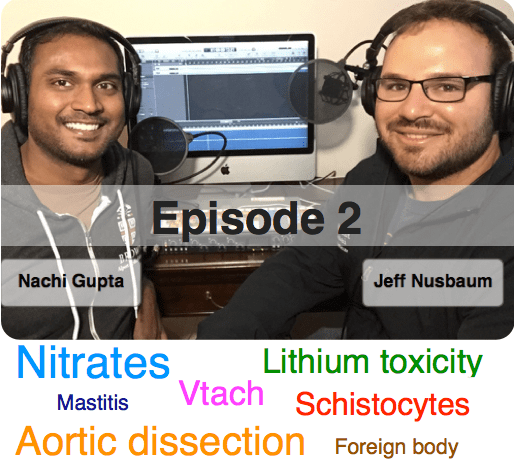Podcast Ep 2: Lithium, Mastitis, Nitrates, Schistocytes, & More

Welcome back to Roshcast Emergency Medicine Board Review Episode 2. Similar to how ED physicians have no control over the next patient who rolls through the door, we are going to, once again, answer questions as they are randomly generated by the emergency medicine question bank.
Click here if you missed episode 1.
Remember, we need your feedback. Please send it to feedback@roshreview.com
Let’s get started.
Question 1
Nitrate therapy works by which of the following mechanisms?
A. Reducing afterload
B. Reducing both preload and afterload
C. Reducing cardiac contractility
D. Reducing preload
Teaching card to supplement answer
Question 2
What is the most common exam finding reported in patients with acute aortic dissection?
A. Aortic insufficiency
B. Hypertension
C. Hypotension
D. Pulse deficit
Teaching card to supplement answer
Question 3
A 32-year-old woman, who is at 20 weeks gestational age, presents to the ED after a seizure. Her vital signs are BP 115/70, HR 105, RR 16, T 37.5°C, and pulse oximetry 98% on room air. On exam, you note some confusion, but otherwise there are no focal deficits. Lab results reveal a hemoglobin of 7 g/dL and platelets of 12,000/µL. A peripheral blood smear reveals schistocytes. Which of the following is the most appropriate treatment for her condition?
A. Delivery of fetus
B. Magnesium sulfate
C. Plasmapheresis
D. Platelet transfusion
Teaching card to supplement answer
Question 4
A 72-year-old man presents for evaluation of palpitations. He has a regular, wide complex tachycardia at a rate of 140. Which of the following supports a diagnosis of ventricular tachycardia?
A. Discordance of the QRS axis in the precordial leads
B. Fusion beats
C. Leftward axis
D. ST elevation greater than 5 mm
Teaching card to supplement answer
Question 5
A 3-year-old girl presents to the ED with her mom and grandmother for evaluation of vaginal spotting. The child has no other complaints and specifically denies sexual abuse or trauma when questioned alone. After watching a news special on sexual abuse, mom is concerned that her daughter may have been sexually assaulted, despite no specific concern. The child is acting appropriately and there are no external lesions or signs of trauma. Internal pelvic exam is difficult due to the patient’s age. Which of the following statements is true?
A. Obtain a pelvic x-ray prior to attempting a physical exam
B. She is the victim of abuse; do no further evaluation without a trained nurse present and contacting authorities
C. She may have a vaginal foreign body; consider a nasal speculum to attempt visualization and removal
D. Vaginitis is an unusual diagnosis in this age group
Question 6
A 27-year-old woman currently breast-feeding presents to the ED with an inflamed and painful right breast. Her vital signs are BP 125/70 mm Hg, HR 105, RR 16, and T 38.3°C. On exam, you note extensive cellulitis of the right breast that begins at the nipple. You begin antibiotic therapy. The patient wants to know whether to continue breast-feeding. What should you advise her to do?
A. Consult her obstetrician
B. Continue to breast-feed but only from the uninfected breast
C. Continue to breast-feed from both breasts
D. Wean from breast-feeding and begin formula feeding
Teaching card to supplement answer
Question 7
A 34-year-old woman with schizophrenia presents with tremors and confusion. Her vital signs are unremarkable. Physical examination reveals confusion and hyperreflexia. The patient has a serum sodium of 165 mEq/dl. Labs show a lithium level of 4.2 mEq/L. After intravenous hydration, what treatment should be initiated?
A. Activated charcoal
B. Bicarbonate infusion
C. Gastric lavage
D. Hemodialysis
Teaching card to supplement answer

- Nitrates reduce both preload and afterload by dilating vascular smooth muscles.
- The most common finding in aortic dissection is hypertension.
- TTP is treated with plasmapheresis. If plasmapheresis cannot be performed expediently, FFP can be used as a temporizing measure.
- Fusion beats are commonly seen in ventricular tachycardia. Do not confuse fusion beats with capture beats, which are normal narrow supraventricular beats within a run of wide complex beats.
- Vaginitis is common in young females. Always keep potential child abuse on the differential, even if suspicion is low.
- Febrile mastitis is treated with dicloxacillin. Mothers should be instructed to continue nursing from the affected breast.
- Lithium toxicity with a lithium level greater than 4 mEq/L in an acute ingestion or a level greater than 2.5 mEq/L in a chronic ingestion requires emergent dialysis. Emergent dialysis should also be initiated if there are any neurologic findings secondary to the ingestion.
- Bradycardia, T wave flattening, and QTc prolongation can all be seen with lithium toxicity.
Please provide us feedback at feedback@roshreview.com Hopefully you enjoyed listening to this week’s episode and learned a thing or two as well. Don’t forget to subscribe to Roshcast on your favorite media player (iTunes, downcast, etc.) to ensure you will be the first to know about new episodes as they go up.
Until next time,
Jeff and Nachi
P.S. Have you ever asked a board review company what their pass rate is? Have they ever given you an answer…such as 99% of people who use our product pass their board exam. Well…we believe board review course pass rates are bogus. Pseudoscience at best.





Comments (0)